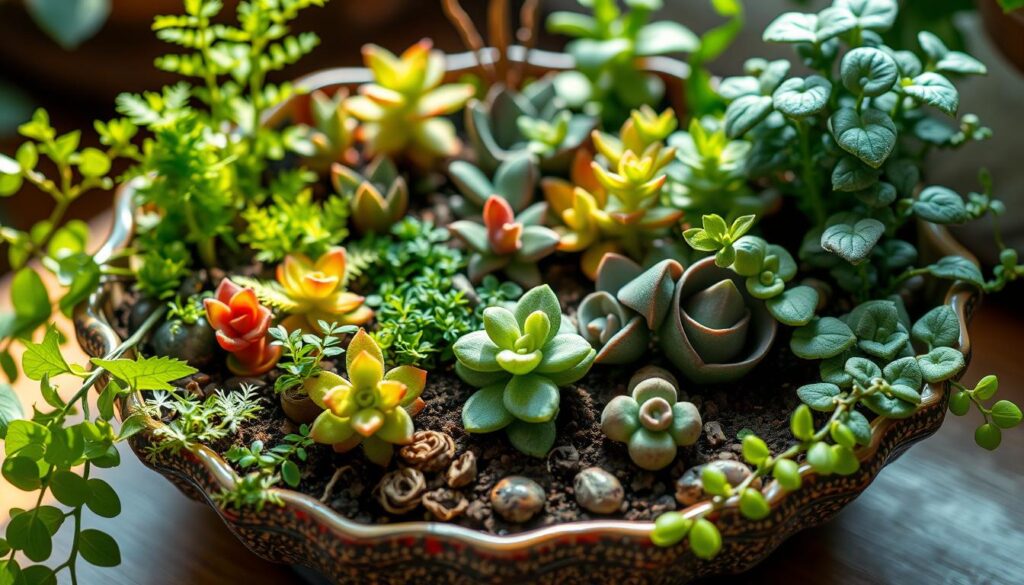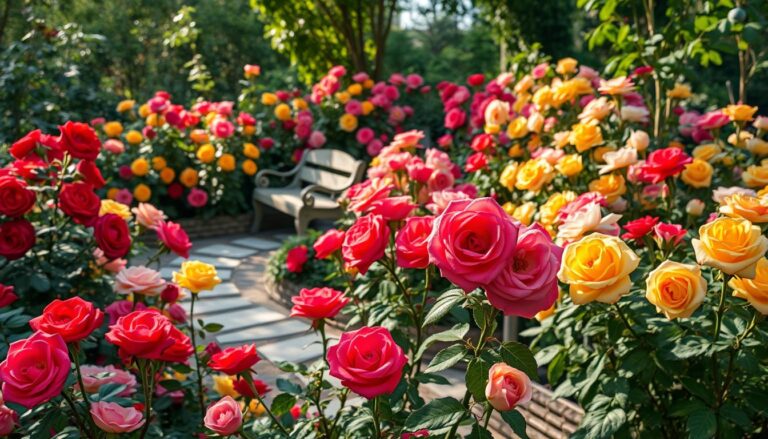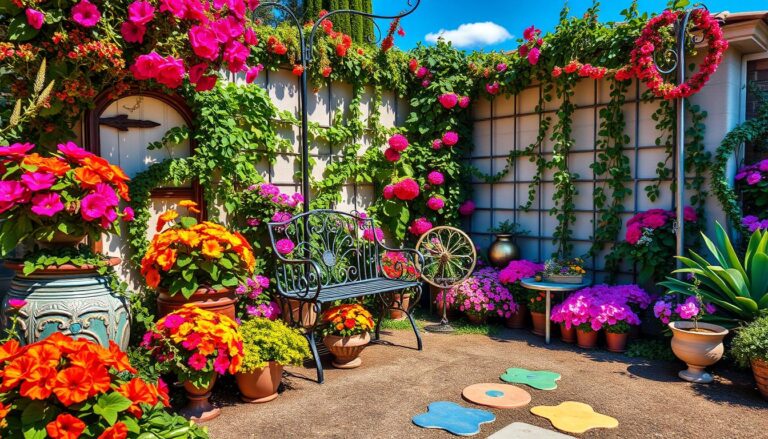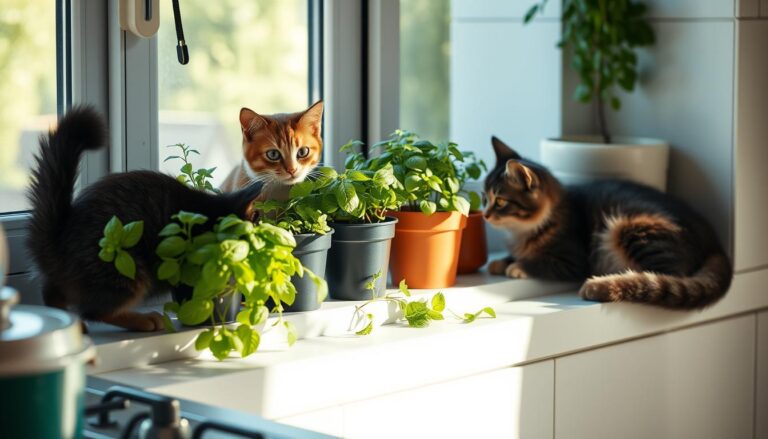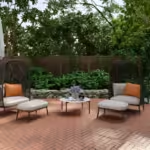Imagine having a beautiful dish garden at home. It’s filled with vibrant plants that add color and texture. You can create a stunning succulent arrangement that brings joy and serenity.
Choosing the right plants is key. Consider lighting, watering, and maintenance. This will help your garden thrive.
By picking the perfect plants, you can make a unique and thriving indoor garden. It will enhance your home’s look. With care, your garden will flourish, giving you a sense of pride.
Let’s explore dish gardening together. We’ll find the perfect plants for your space. This includes beautiful succulent arrangements and other stunning plants.
Introduction to Dish Gardens
If you love plants, you might know about small space gardening. It’s about making beautiful gardens in tiny areas. Dish gardens are a great example, being mini landscapes in shallow containers. They let you add greenery to your home and enjoy nature indoors.
Creating a dish garden is fun because you can choose many plants. You can pick succulents, ferns, or flowers for a unique look. It’s important to pick plants that need the same things, like light and water, so they all do well together. With the right plants and a nice container, your dish garden can make your home look better and clean the air.
Some good plants for dish gardens are kalanchoe, aloe, and jade. They have cool textures and colors. These plants are great for small spaces and can make your dish garden look amazing. Adding plants to your home can make it more peaceful and relaxing.
- Enhances indoor space with a touch of greenery
- Purifies the air and promotes a healthy environment
- Allows for creative expression and customization
- Perfect for small space gardening and plant enthusiasts
By following these tips and picking the right plants and container, you can make a beautiful dish garden. It will make your home look better and be a calm place. Whether you’re new to plants or have been growing them for a while, dish gardens are a great choice.
Selecting the Right Container
Choosing the right container is key for a beautiful dish garden. You need a container that looks good and gives your plants enough room. With many options, picking the perfect one can be tough. Think about the size and material to ensure your plants thrive.
A 24-inch pot fits one big pepper or tomato. An 18-inch pot is good for broccoli or cauliflower. For herbs or small plants, a 14-inch pot works best. Pick a size that fits your plants and the space they’ll be in.
You can choose from glass, ceramic, or wood containers. Terracotta dries out faster, while ceramic is heavier. Think about what’s best for your plants, like drainage and moisture. Use unique plant arrangements and creative plant displays to make your garden stand out.
Half-barrels are great for big plants, and wooden containers last long but get heavy. The best container is one that matches your style and plant choices. With the right container and care, your dish garden will be a joy to have.
Popular Dish Garden Plants
Choosing plants for your dish garden is exciting. Succulents are a top pick because they need little water and care. Mixing succulents with other plants makes your dish garden stand out.
Ferns bring lush greenery, while flowering plants add color. Think about the light and water each plant needs. For example, African violets need bright light and special soil. Snake plants, on the other hand, can handle low light and don’t need much water.
Here are some popular dish garden plants to consider:
- Succulents: Echeveria, Crassula, and Sedum
- Ferns: Boston ferns and maidenhair ferns
- Flowering plants: African violets, bromeliads, and mini roses
Choose plants that fit your climate and the light your dish garden gets. The right mix of plants makes a beautiful, thriving dish garden. Try combining succulents with other plants for a unique look.
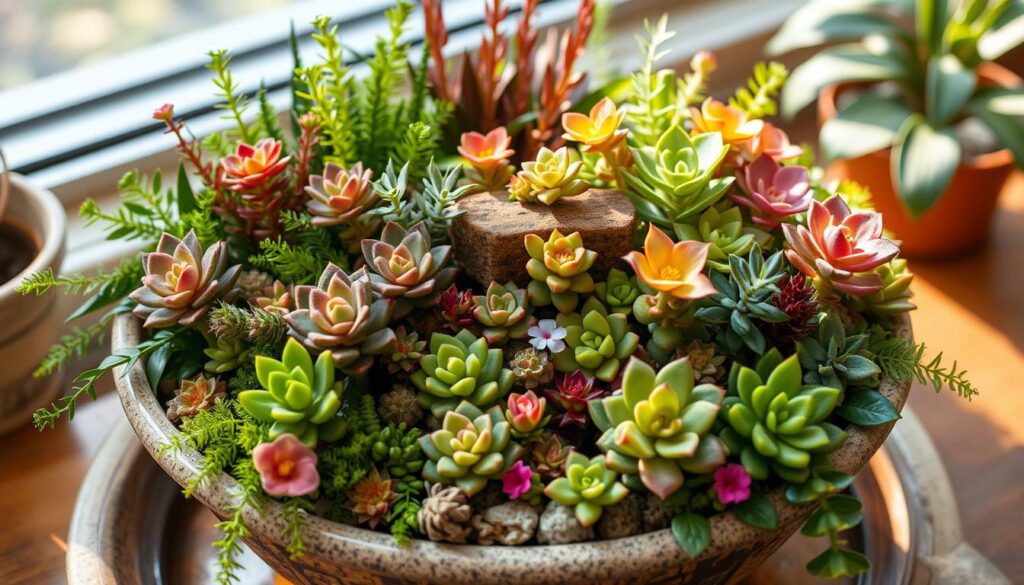
| Plant | Lighting Requirements | Watering Requirements |
|---|---|---|
| Succulents | Low to medium light | Infrequent watering |
| Ferns | Medium to bright light | Regular watering |
| Flowering plants | Medium to bright light | Regular watering |
Soil and Drainage Considerations
As a plant enthusiast, you know how key soil and drainage are for your dish garden. In small space gardening, picking the right potting mix is vital. A mix that drains well can stop waterlogged soil, which causes root rot and other issues. Look for a mix with one part sand or perlite, one part soil, and one part peat moss for the best drainage.
For your dish garden, making sure it drains well is crucial. Adding a layer of gravel or charcoal at the bottom helps. It stops water from staying in the soil and cuts down root rot risk. By doing these things, you can make a dish garden that thrives and adds beauty to your small space.
- Choosing a potting mix that is designed for small spaces
- Adding a layer of gravel or charcoal to the bottom
- Ensuring the container has proper drainage holes
By following these tips, you can make a dish garden that’s healthy and brings joy for years.
Sunlight Requirements for Dish Gardens
Creating a thriving dish garden starts with knowing the sunlight needs. Each plant has its own light requirements. The right spot can make a big difference.
For most indoor plants, east- and west-facing windows are perfect. They offer bright, indirect light without being too harsh.
A well-thought-out plant decor can also enhance sunlight for your garden. Mirrors or reflective surfaces can bounce light onto your plants. This makes the space brighter and more inviting. Plus, creative plant displays add visual appeal and make the most of the light.
- Light intensity: Most houseplants prefer bright, indirect light, but some can tolerate direct sunlight.
- Window direction: East- and west-facing windows are ideal, while south-facing windows may be too intense.
- Room conditions: Avoid placing your dish garden near heating or cooling vents, fireplaces, or drafty windows.
By understanding your dish garden’s sunlight needs and using creative plant displays and plant decor, you can create a thriving and beautiful indoor space. This space will showcase your indoor plants beautifully.
| Window Direction | Light Intensity | Ideal for |
|---|---|---|
| East- and West-facing | Bright, indirect | Most houseplants |
| South-facing | Direct sunlight | Cacti and succulents |
| North-facing | Low, indirect | Chinese Evergreen, Pothos |
Watering Techniques for Dish Gardens
Watering is key in caring for dish gardens. Check soil moisture by sticking your finger in up to the first knuckle. Water only when it’s dry. Use a long-necked watering can to water gently and avoid soil loss.
Each plant in your garden has its own watering needs. Some, like cacti, need little water. Others, like pothos or peace lilies, need more. Water your dish garden every 2 weeks in warm weather and 3-4 weeks in winter.
Here are some tips for watering your dish garden:
- Water at the bottom of the plant to reach the root system
- Empty excess water from the drip tray or saucer within 30 minutes
- Adjust watering frequency based on factors like plant positioning, soil weight, and additional topdressings
By following these tips and understanding your plants’ needs, you can create a thriving dish garden. It will add joy and beauty to your small space gardening setup.
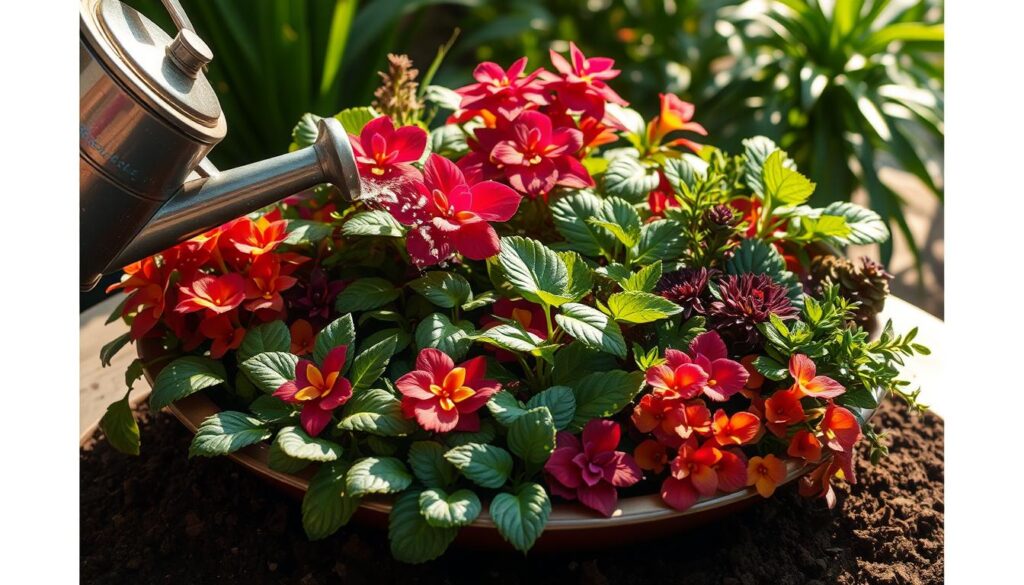
| Plant Type | Watering Requirements |
|---|---|
| Cacti | Little water, less than 1 inch per month |
| Pothos or Peace Lilies | More consistent watering, every 2-3 weeks |
Maintaining Your Dish Garden
As a plant enthusiast, you know how crucial regular care is for a healthy dish garden. Pruning and trimming are key to encourage growth and prevent plants from getting too long. Think about the look you want and balance your plants to achieve it.
For fertilizing, use a balanced, water-soluble fertilizer but dilute it to half strength. This is vital during the growing season to feed your plants well. Important steps for keeping your dish garden in top shape include:
- Pruning and trimming plants regularly to promote healthy growth
- Fertilizing plants during the growing season with a balanced, water-soluble fertilizer
- Providing the right amount of light and water for your plants, depending on their specific needs
By following these tips and understanding your plants’ needs, you can create a stunning dish garden. It will add beauty and calm to your space. Whether you’re new to plants or experienced, with proper care, your garden will reflect your style.
| Plant Type | Light Requirements | Watering Frequency |
|---|---|---|
| Cacti | High light | Low water |
| Pothos and Peace Lilies | Low light | More water |
Remember, caring for your dish garden is a continuous task. It needs your attention and flexibility to meet your plants’ changing needs. With the right care, your garden will flourish, bringing joy and peace into your life.
Troubleshooting Common Issues
Creating and keeping a dish garden with indoor plants needs attention to common problems. Regular checks can spot issues like pests, diseases, and nutrient gaps. This lets you act fast to avoid more harm.
Watch out for too much or too little water. Too much can rot roots, while too little stresses plants. Also, look for pests like spider mites and mealybugs. Treat any problems with organic methods.
To avoid these issues, pick the right plants and designs for your garden. Choose plants that need similar water and have good air flow. This helps prevent diseases. Here are some tips to remember:
- Choose plants that are compatible with each other in terms of watering needs and growth habits.
- Provide good air circulation to prevent the spread of diseases.
- Monitor the plants regularly for signs of pests and diseases.
- Use organic pest control methods to treat any infestations.
By following these tips and watching for common problems, you can have a thriving dish garden. It will be filled with beautiful plants and unique designs that add joy and beauty to your space.
| Common Issue | Cause | Solution |
|---|---|---|
| Overwatering | Too much water | Reduce watering frequency |
| Underwatering | Not enough water | Increase watering frequency |
| Pests | Infestation | Use organic pest control methods |
Creative Designs for Dish Gardens
As a plant enthusiast, you can make your dish garden stand out. Create unique plant arrangements that reflect your style. Layer plants of different textures and heights for a stunning look. Mix succulents, ferns, and flowers for a beautiful display.
To make your dish garden more interesting, add decorative elements. Use rocks, pebbles, or driftwood. These add personality and make your garden special. Try different container shapes and sizes for a unique look.
Here are some ideas for unique plant arrangements: * Mix plants with different leaf shapes and textures. * Use various container shapes and sizes. * Add decorative elements like rocks or driftwood. * Create themed gardens, like tropical or desert ones. Follow these tips to create a beautiful creative plant display. It will show off your style and add elegance to your space.
Final Thoughts on Dish Gardening
Dish gardening is a fun and rewarding hobby. It lets you pick the right plants and care for them. You can turn a small area into a lush oasis.
It’s easy to care for dish gardens, even if you’re new to gardening. This article has tips to help you grow a beautiful dish garden. It will make your home more beautiful and peaceful.
If you want to start dish gardening, look for online forums and blogs. You can also visit local nurseries for more ideas. With creativity and a love for plants, you can make a stunning dish garden. It will bring joy and calm to your home.
FAQ
What is a dish garden?
A dish garden is a small indoor garden in a shallow container, like a bowl. It lets you see plants up close and try out different designs.
What are the benefits of creating a dish garden?
Creating a dish garden lets you enjoy plants up close. You can also try out new designs and purify the air in your home.
What type of container is best for a dish garden?
Choose a container that’s the right size and material. It should let plants grow well. Glass, ceramic, and wood are good choices.
What plants are commonly used in dish gardens?
Succulents, ferns, and flowering plants are popular. Pick plants that match your lighting and watering needs.
How do I ensure proper soil and drainage for my dish garden?
Use a potting mix that drains well. Add gravel or charcoal at the bottom to help with drainage and prevent root rot.
What lighting conditions are best for a dish garden?
East- and west-facing windows are best for most plants. South-facing windows might be too bright for some.
How often should I water my dish garden?
Check the soil moisture often. Water only when it’s dry. Too much water can cause root rot, while too little can stress plants.
What maintenance does a dish garden require?
Regular pruning and trimming are key. Fertilize during the growing season to keep your garden healthy.
How do I address common issues with my dish garden?
Watch for pests, diseases, and nutrient deficiencies. Use organic pest control and fix problems quickly to keep your garden healthy.
How can I create visually appealing dish garden designs?
Try layering plants of different textures and heights. Add decorative elements like rocks or driftwood to make your garden interesting.

